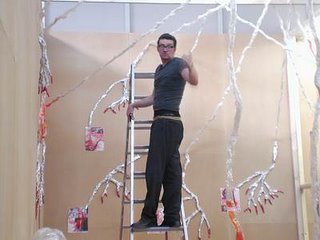Grappling with Hirschhorn
 Jerry Salz recently wrote about Thomas Hirschhorn's new show at Barbara Gladstone. Since I live in L.A., I don't think I'll get the chance to see it any time soon, but I did get to visit "Utopia, Utopia = One World, One War, One Army, One Dress" while I was in Boston over new year's. The show, comprehensive as the examples of camoflauge were, was tiring. Hirschhorn brings up a good point in the show's introductory video, though: isn't it weird that camoflauge is both militant uniform and a sometimes-trendy fabric. And that's what sets the tone for the rest of your tour. I really loved the video, and the dollhouses, and the Barbie dolls doing splits in those dollhouses. And I love it when he tries to tape over un-tape-able places and inserts those cancerous-looking protrusions. They're really interesting aesthetic cues that clue us into the open-ness of his work; that great, fresh, unfinished quality about it, and his interest in the abject. But, I still hunger for something as enveloping as "Cavemanman".
Jerry Salz recently wrote about Thomas Hirschhorn's new show at Barbara Gladstone. Since I live in L.A., I don't think I'll get the chance to see it any time soon, but I did get to visit "Utopia, Utopia = One World, One War, One Army, One Dress" while I was in Boston over new year's. The show, comprehensive as the examples of camoflauge were, was tiring. Hirschhorn brings up a good point in the show's introductory video, though: isn't it weird that camoflauge is both militant uniform and a sometimes-trendy fabric. And that's what sets the tone for the rest of your tour. I really loved the video, and the dollhouses, and the Barbie dolls doing splits in those dollhouses. And I love it when he tries to tape over un-tape-able places and inserts those cancerous-looking protrusions. They're really interesting aesthetic cues that clue us into the open-ness of his work; that great, fresh, unfinished quality about it, and his interest in the abject. But, I still hunger for something as enveloping as "Cavemanman". And I'm beginning to believe that he'll never really top "Cavemanman". (Michael Kimmelman's review certainly does justice to the show.) It was the perfect forum for him to be excessive with aluminum foil, with flourescent lights, with gobs of packing tape and cardboard. It was so great because the entire environment was transformed such that you believed the world he was describing--its endlessness, its hopelessness--and you wanted to get a better sense of what a dude in an aluminum cave would want to start thinking about in his isolation. Plus, the different caves were so much fun to wander around in and out of. When I went, there were kids playing in the little alcoves, really delighting in this strange amusement -- and it proved that great contemporary art can be entertaining for everyone, and especially fruitful if you wanted to figure out how foil-covered mannequins and gigantic replicas of volumes of Heidegger and Foucault could coexist in the same space. It changed the way I looked at art entirely, for all its subversiveness, and for all its ridiculous yet well-thought out aesthetics.
Hirschhorn's most recent taxonomies are interesting, but they don't have that same jolt. It's not so much because we've seen what he's done before (because we certainly haven't), but rather something else: these current jabs at the real world don't feel quite so successful for me because he's confronting a present condition, not extracting us from it. What I loved most about Cavemanman was the fact that Hirschhorn created an environment/work/tiny amusement park that was historical, transformative, gritty, and slapdash. It was basically the ultimate art funland, even though it was deviously serious. It raised my expectations for what installation could be. I suppose, in a way, you could say that Hirschhorn made his own bed, and the beds for all the other people who try to create environments in their work, and try to make them smart and interesting and fun all at the same time. And even though it makes it harder, for that, he's got to be one of the most pivotal figures of art in the early 21st century.

0 Comments:
Post a Comment
<< Home